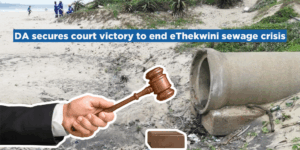Where development happens and the form it takes has a long-term effect on residents’ quality of life. It can either affirm entrenched inequalities and inefficiencies, or correct imbalances created by apartheid spatial planning. The City has issued its draft revised Municipal Spatial Development Framework which outlines how we intend to transform Cape Town’s spatial form with public-led investment within an Urban Inner Core and by pursuing transit-oriented development.
Spatial transformation must reverse the impact of apartheid spatial planning by creating more jobs for people in highly connected areas. It must also counter the creation of new low-income communities on the outskirts of Cape Town and reduce the high cost of transport.
‘The majority of lower-income households live on the periphery of the city, travelling long distances and spending nearly half of their monthly income on transport. These households are situated in highly dense, under-serviced, predominantly informal areas, and travel at great cost to sparsely populated, well-serviced areas of Cape Town where jobs and services are located. Coupled with worsening traffic congestion and ongoing development on the outskirts of the city where land is cheap, living and working in Cape Town is becoming increasingly unsustainable and expensive. This is the case for residents, as well as for the City in terms of the maintenance and provision of bulk infrastructure for roads, water, electricity and sanitation, and the delivery of affordable housing and public transport,’ said the City’s Mayoral Committee Member for Transport and Urban Development, Councillor Brett Herron.
The City is also facing new challenges, or drivers of urban change, which have shifted profoundly since 2012.
‘There is a rapid increase in the number of new households – although the population has increased by 7% between 2011 and 2016, the number of households has increased by 18%. This affects the number and type of housing opportunities to be delivered. Faced by fiscal constraints and a tepid global and local economy, we must do more with less – meaning, we have to improve our spatial form to ensure resource efficiency and sustainability.
‘Furthermore, cities are increasingly under pressure from climate change. The current drought is a clear indication that we cannot continue with a business-as-usual approach where Cape Town continues to sprawl with the poor living on the margins. If allowed to do so, our energy consumption and emissions would double by 2040. Transport would dominate our energy footprint and we would have more private vehicles travelling long distances on highly congested roads, with devastating effects on our natural environment,’ said Councillor Herron.
As such, the Transport and Urban Development Authority (TDA) has revised the Municipal Spatial Development Framework (MSDF) to spatially reflect the vision and priorities identified in the City’s Integrated Development Plan (IDP), key among them being rapidly transforming Cape Town’s spatial form, taking into account the new challenges mentioned above.
The City’s revised MSDF drafted in support of the City’s recently approved Integrated Development Plan for the period 2017 to 2022 is now available for public comment until 26 September 2017. Once approved by Council, the MSDF will guide and inform long-term planning and development in Cape Town.
‘The MSDF is an important strategic planning instrument – it determines the spatial form we will pursue in the years ahead to create a city that is liveable, equitable, sustainable, resilient and efficient, and supports the creation of economic opportunities and social inclusion.
‘The MSDF guides public and private investment decisions that will affect Cape Town’s future spatial structure. Its purpose is to achieve a balance between spatial equity, economic competitiveness, and environmental sustainability. For example, the Municipal Planning Tribunal’s decisions on land development applications are based on the MSDF. The MSDF is also the principal policy tool when the City evaluates applications for new or enhanced land use rights,’ said Councillor Herron.
Simply put, the MSDF identifies areas suitable for urban development and catalytic interventions to achieve spatial transformation; areas where the impact of development must be managed; and areas not suited for urban development. It guides decision-making on the nature, form, scale and location of urban development, land use, the maintenance and development of infrastructure, and the protection of environmental resources.
‘Fundamental to the revised MSDF is the commitment to build integrated communities with different types of residential developments based on a mix of income groups. Going hand in hand with this vision is the imperative to sustain employment-generating economic growth and to reduce accessibility costs for the urban lower-income households,’ said Councillor Herron.
For this to happen, Cape Town must be spatially transformed.
‘In this sense, the City will implement dense and transit-oriented growth and development, supported by an efficient and integrated transport system. Meaning, we will actively pursue higher densities and mixed land use patterns within an Urban Inner Core which is serviced by an efficient bus rapid transit and rail network,’ said Councillor Herron.
Going forward, the City will prioritise public investment and incentivise private investment in integration zones and along main transit corridors within this Urban Inner Core. Broadly speaking, the Urban Inner Core includes areas adjacent to the N1, N2, N7, and M5 highways; along the R27 to the north and Main Road to the south; along major arterials linking the metro-south east with Bellville and Kuils River; and the Cape Town International Airport.
‘Apart from transit corridors, investment will be pursued at key business nodes and transit-accessible precincts – these are precincts within 500 m of a rail or bus station. We will promote diverse development with a mix of commercial and residential opportunities at higher densities around 98 rail stations and 42 MyCiTi stations. The City will take the lead by investing public money in catalytic projects and will incentivise private investment to follow suit. The objective is to reduce urban sprawl and to promote inward growth on vacant and under-utilised land close to transit corridors and in areas with great potential for economic opportunities,’ said Councillor Herron.
Examples of nodes where the City will prioritise investment are as follows:
- The Cape Town central business district
- Mitchells Plain and Khayelitsha CBDs
- Bellville, Claremont and Wynberg CBDs
- Somerset West and Philippi
Examples of the road corridors where the City will pursue TOD are as follows:
- Along Voortrekker Road (from the Cape Town CBD to the Bellville CBD)
- Along Main Road in the southern suburbs
- Along the R27, Marine Drive, Koeberg Road, and Blaauwberg Road
- Along Walter Sisulu and Govan Mbeki Roads in Khayelitsha
- Along AZ Berman Drive in Mitchells Plain
- Along Symphony Way towards Bellville
Examples of the rail corridors where the City will pursue TOD are as follows:
- Chris Hani to Cape Town
- Simon’s Town to Cape Town
- Wellington to Cape Town via Woodstock
- Kapteinsklip to Cape Town via Woodstock and Pinelands
- Strand to Cape Town via Kuils River and Bellville
‘Going forward, the City will prioritise development and public expenditure within the Urban Inner Core mentioned above. This area will be the focus of incentives and regulatory reform in support of spatial transformation. We must unlock development which can create large-scale economic opportunities within close proximity to areas of social need. We must also facilitate economic growth and meet the special needs of those sectors and businesses that are attracted to and operate in Cape Town,’ said Councillor Herron.
City analysis confirms we have approximately 18 400 ha of developable land within the city. It is a long-term priority to raise city-wide densities and reduce the average transport costs. The emphasis on inward growth is vital as we need to achieve larger-scale efficiencies for the provision of bulk infrastructure and public transport.
‘This means we will target densification in specific locations and along priority corridors. At the same time, we have to deter developments on the periphery as the cost burden of maintaining infrastructure and the provision of services is unsustainable in these locations,’ said Councillor Herron.
As such, the MSDF proposes:
- the regeneration of underperforming inner-city business nodes such as Salt River, Maitland, Goodwood, Parow, Athlone, and Bellville
- infill development of large underutilised land within the city
- in-situ residential intensification within well-located but traditionally low-density suburbs through second and third dwellings and cluster housing
‘Dove-tailing these proposals is the commitment to make Cape Town more attractive for business start-ups, investment, innovation and employment. In this sense the MSDF can influence economic growth by directing infrastructure provision, land availability and urban management. We will unlock affordable and efficient market-driven densification at scale in inner-cities through capital investment in transport and the upgrading of bulk and network infrastructure for utility services,’ said Councillor Herron.
The public can access the draft MSDF at the City’s libraries or on the City’s website here. The closing date for public comment is 26 September 2017.
‘Last year Council adopted the ODTP which prioritises redress through targeted investment based on transit-oriented development. Transport networks are critical to Cape Town’s spatial transformation and the MSDF has been adapted to mirror this focus which must assist us in alleviating poverty and inequality. I encourage residents to please read the document and let us know their thoughts,’ said Councillor Herron.




